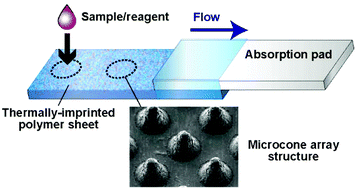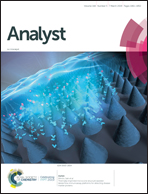Thermally imprinted microcone structure-assisted lateral-flow immunoassay platforms for detecting disease marker proteins
Abstract
Although various types of on-site immunoassay platforms have been developed, facile and reliable sample-to-answer immunoassay systems are still under development. In this study, we proposed a lateral-flow immunoassay system utilizing a polymer sheet with microcone array structures fabricated by thermal imprinting. By adding a surfactant to the running/washing buffer, we were able to dispense with complicated chemical modification protocols, which are usually necessary to enhance antibody adsorption. We investigated three types of polymeric materials and confirmed that polycarbonate is most suitable as an imprinted polymer substrate. Experiments using microcone arrays with different distances revealed that the increased surface area with nanometer-scale surface roughness was key to achieving stable immobilization of antibodies. To assess the applicability of this assay to clinical diagnosis, C-reactive protein in a pure buffer and in a serum sample was analyzed as a model, with a ∼0.1 μg mL−1 lower limit of detection. The presented approach would open a new path to the development of immunoassay-based on-site point-of-care testing by virtue of its simplicity of operation, high sensitivity, and versatility.



 Please wait while we load your content...
Please wait while we load your content...